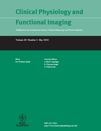Variation and reliability of ultrasonographic quantification of the architecture of the medial gastrocnemius muscle in young children
Summary
The aim of this study was to evaluate the suitability of ultrasonography for the quantification of gastrocnemius muscle architecture in healthy young children. The variation and reliability of measurement of muscle thickness, pennation angle and fibre length of the medial gastrocnemius were determined, using stationary and portable ultrasound machines, in 13 boys and eight girls aged 4–10. Ultrasound images were obtained from each leg, in duplicate, with the ankle at 90°, then at maximal plantar flexion, with the two machines within the same session. The same set of 16 scans was repeated in four children 4–6 weeks later. The mean muscle thickness, pennation angle and fibre length differed between ankle positions and between legs. Measurements obtained using the two machines established similar values with no significant differences in absolute values and coefficients of variation (CV). For duplicate images taken during the same session for the same leg, ankle position and machine, the CV and intraclass correlation coefficients (ICC) ranged, respectively, from 2·1% to 3·1% and 0·94–0·98 for muscle thickness, from 4·1% to 6·0% and 0·85–0·96 for pennation angle and from 4·5% to 6·3% and 0·87–0·96 for fibre length. Corresponding values for variables for the same child measured on two separate occasions were within the same ranges, all being similar to reliability data reported previously for adult muscle. Muscle thickness, pennation angle and fibre length of the medial gastrocnemius can therefore be quantified reliably, using either a stationary or portable ultrasound machine, in healthy young children.




